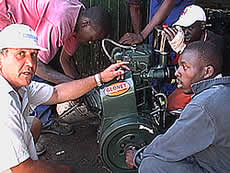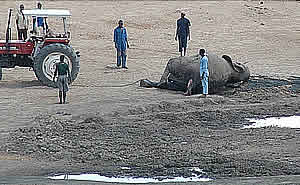|
Back to Index
Hwange
crisis update
Zimbabwe Conservation Task Force (ZCTF)
November 21, 2005
  Thanks
to those of you who assisted with funds, especially the SAVE Foundation
of Australia, I was able to go to South Africa and purchase 2 new
engines for the pumps in Hwange National Park as well as enough
spare parts to repair another 20 engines. Thanks to Expeditors for
clearing the goods so quickly and efficiently at the border. Thanks
to those of you who assisted with funds, especially the SAVE Foundation
of Australia, I was able to go to South Africa and purchase 2 new
engines for the pumps in Hwange National Park as well as enough
spare parts to repair another 20 engines. Thanks to Expeditors for
clearing the goods so quickly and efficiently at the border.
In view of the
critical situation up in Hwange, I went straight from South Africa
to Hwange to try and get some water pumping as soon as possible.
I delivered half the spares and one engine to Sinamatella and the
balance to Robins Camp.
Joanne Buckley
Lamb, a ZCTF team member has been based in Sinamatella for the past
month. She has been monitoring the distribution of the fuel we delivered
and she has been doing a wonderful job motivating the workshop staff
to try and make up working engines out of the engines that aren't
working. By doing this, she managed to get some water pumping at
a few of the dry pans before I arrived but she has had some heartbreaking
experiences during the past month.
  In
the small number of pans with water, the water levels are so low
that the animals are having to wade into deep mud before being able
to reach the water. In some places, the mud is more than 3 feet
deep and in their desperation for water, the animals are inadvertently
walking into a death trap because once they are stuck in the mud,
they can't get out and many have died in the mud. National Parks
staff are working against great odds to try and rescue these animals.
In the case of the larger animals, like elephants this involves
pulling them out using chains or rope and a tractor and sometimes
the stress of this operation kills the animal anyway. In
the small number of pans with water, the water levels are so low
that the animals are having to wade into deep mud before being able
to reach the water. In some places, the mud is more than 3 feet
deep and in their desperation for water, the animals are inadvertently
walking into a death trap because once they are stuck in the mud,
they can't get out and many have died in the mud. National Parks
staff are working against great odds to try and rescue these animals.
In the case of the larger animals, like elephants this involves
pulling them out using chains or rope and a tractor and sometimes
the stress of this operation kills the animal anyway.
In the case
of smaller animals, National Parks staff are wading, sometimes chest
deep into the mud and rescuing them by pulling them out of the mud
manually.
  These
dedicated National Parks staff are doing the best they can with
very limited resources. Most of them are devoted to the welfare
of the wildlife but they are short of chains and ropes and very
few of their vehicles are mobile because they have no tyres. I saw
numerous National Parks vehicles up on stands with no tyres. A
very big thank you to Nets and Ropes who have donated 47kg of rope,
Columbus McKinnon who are very kindly donating chains, AAT who have
donated some tyres and Hivos who donated 2 500 litres of diesel.
I will be taking all of this up to Hwange later this week. These
dedicated National Parks staff are doing the best they can with
very limited resources. Most of them are devoted to the welfare
of the wildlife but they are short of chains and ropes and very
few of their vehicles are mobile because they have no tyres. I saw
numerous National Parks vehicles up on stands with no tyres. A
very big thank you to Nets and Ropes who have donated 47kg of rope,
Columbus McKinnon who are very kindly donating chains, AAT who have
donated some tyres and Hivos who donated 2 500 litres of diesel.
I will be taking all of this up to Hwange later this week.
Our first task,
after delivering the spares to Sinamatella was to install a new
engine at Inyantuie and get the water pumping into the pan there.
It was a great
pleasure to hear the new engine fire up for the first time and watch
the dry trough filling with water.
From there,
we moved on to Shumba, still in the Sinamatella area where we did
some minor repairs to the engine and fired it up. An engine which
was supposed to be pumping water for drinking and toilet facilities
at one of the National Parks safari camps was out of order so we
repaired that as well.
We then went
to Robins camp, delivered the rest of the spare parts and installed
the second new engine at Little Tom. It was music to our ears to
hear the engine start up because Little Tom hasn't had water for
quite some time.
Our final stop
in the Robins Camp area was Detema Pan where the engine wasn't pumping
because it needed oil so we filled it with oil and fired it up.
  We
then made our way through Hwange National Park towards the Main
Camp area. Whilst travelling from pan to pan, we saw a number of
carcasses of animals that had succumbed to either dehydration or
the "black leg" disease which was a terrible thing to see especially
in the case of the elephants. It is not yet known for sure what
causes this disease but it is thought that it may be due to not
enough water being consumed or the fact that the animals are standing
in contaminated mud for long periods of time. The feet start rotting,
similar to gangrene and eventually the bones rot and break. There
is no cure for this disease and the kindest thing to do is to put
the animal down. We
then made our way through Hwange National Park towards the Main
Camp area. Whilst travelling from pan to pan, we saw a number of
carcasses of animals that had succumbed to either dehydration or
the "black leg" disease which was a terrible thing to see especially
in the case of the elephants. It is not yet known for sure what
causes this disease but it is thought that it may be due to not
enough water being consumed or the fact that the animals are standing
in contaminated mud for long periods of time. The feet start rotting,
similar to gangrene and eventually the bones rot and break. There
is no cure for this disease and the kindest thing to do is to put
the animal down.
We are racing
against time in our fight to save the animals in Hwange but we are
slowly making progress thanks to the overwhelming support many of
you are giving us. We still have a lot to do - many of the engines
in the Main Camp area are out of order and most of the pans there
are dry so we are now working on supplying another load of engines
and spares to that area.
There are also
numerous other miscellaneous items required in Hwange to help alleviate
the problem such as:
- Buckets to
wash the mud off the rescued animals
- Pick and
shovels to remove excess mud from the pans
- Tyres, tubes
and tyre repair kits
- Rope
- Engine oil
- Diesel
- Cement to
repair the troughs
- I,5 to 2
ton block and tackle
- 1000m x 1,5
and 2 inch polythene pipe
- 150 x B144
'V' Belts
- 100m fuel
hose
- 8mm gasket
paper
- Silicone
sealer
- 30 and 50hp
submersible pumps
- Pipe wrenches
- all sizes
- 2 inch gate
valves
If anyone has
any of these items lying around would like to help, please contact
us on one of the telephone numbers below. The drop off point is
3 Fairbairn Drive Mount Pleasant. If you would like to email us,
please send a new email to galorand@mweb.co.zw
Visit the ZCTF
fact sheet
Please credit www.kubatana.net if you make use of material from this website.
This work is licensed under a Creative Commons License unless stated otherwise.
TOP
|

